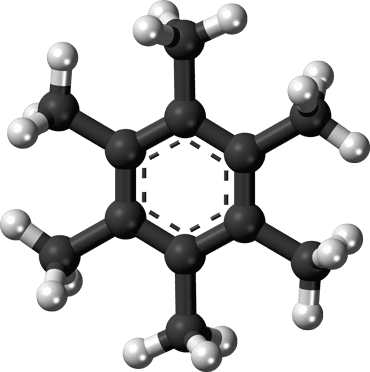According to organic chemistry 101, carbon can form up to four bonds because it only has four shareable electrons. In certain conditions, however, this limit can be broken as German chemists from the Free University of Berlin recently showed.

This is the Hexamethylbenzene molecule. When the molecule loses two electrons, it changes its configuration such that a carbon atom bonds to six other. Credit: Wikimedia Commons.
In the 1970s, another group of researchers from Germany made some intriguing observations about a molecule called hexamethylbenzene which can exist in a stable configuration of six carbon atoms arranged in a flat hexagonal ring. Off each vertex of the ring, an extra carbon atom sticks out where it’s bonded to three hydrogen atom. Finally, leftover electrons which hadn’t been shared zip around the middle of the ring.
More than 40 years ago, the researchers proposed that if you removed two electrons from hexamethylbenzene it would drastically change its shape. According to their calculations, the exotic molecule would rearrange itself into a configuration where one carbon atom was bonded to six other carbons. The implications were staggering but, at the time, no one confirmed the structure experimentally.
Moritz Malischewski and colleagues from the Free University of Berlin decided to sweep the dust off this old paper and try it out. It was a bit difficult at first because the original paper was poor on details but the researchers eventually managed to make the charged hexamethylbenzene molecule.
After the molecule was crystallized, a 3-D map of the crystal’s structure was made using X-rays. Strikingly, the experiment proved that when hexamethylbenzene lost two electrons, it reordered itself in the six carbon bond configuration. Specifically, one carbon atom jumped out of the flat hexagon eventually turning the structure into a five-sided carbon pyramid. The carbon right atop the pyramid was bonded to six other carbon atoms: five in the ring and one above.
Previously, other molecules with a carbon atom associated with more than four bonds have been demonstrated, like Si2(CH3)7+. This is, however, the first molecule associated with six bonds, as reported in the journal Angewandte Chemie.
It’s important to note that the carbon at the top of the hexamethylbenzene reconfigured pyramid still only has four electrons to share. “The carbon isn’t making six bonds in the sense that we usually think of a carbon-carbon bond as a two-electron bond,” Dean Tantillo, a chemist at the University of California, Davis who wasn’t part of the study, told Science News. Instead, the carbon shares electrons among the six bonds. Case in point, when the researchers measured the molecule’s chemical bonds, these were longer than the typical carbon-carbon bond, which means they’re weaker.









